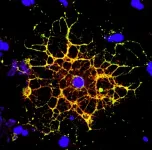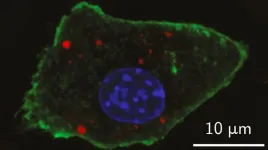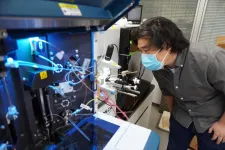(Press-News.org) Boulder, Colo., USA: GSA's dynamic online journal, Geosphere, posts articles online regularly. Locations and topics studied this month include the Moine thrust zone in northwestern Scotland; the Eastern California shear zone; implementation of "OpenTopography"; the finite evolution of "mole tracks"; the southern central Andes; the work of International Ocean Discovery Program (IODP) Expedition 351; and the Fairweather fault, Alaska, USA. You can find these articles at https://geosphere.geoscienceworld.org/content/early/recent.
Detrital-zircon analyses, provenance, and late Paleozoic sediment dispersal in the context of tectonic evolution of the Ouachita orogen
William A. Thomas; George E. Gehrels; Kurt E. Sundell; Mariah C. Romero
Abstract: New analyses for U-Pb ages and εHft values, along with previously published U-Pb ages, from Mississippian-Permian sandstones in synorogenic clastic wedges of the Ouachita foreland and nearby intracratonic basins support new interpretations of provenance and sediment dispersal along the southern Midcontinent of North America. Recently published U-Pb and Hf data from the Marathon foreland confirm a provenance in the accreted Coahuila terrane, which has distinctive Amazonia/Gondwana characteristics. Data from Pennsylvanian-Permian sandstones in the Fort Worth basin, along the southern arm of the Ouachita thrust belt, are nearly identical to those from the Marathon foreland, strongly indicating the same or a similar provenance. The accreted Sabine terrane, which is documented by geophysical data, is in close proximity to the Coahuila terrane, suggesting the two are parts of an originally larger Gondwanan terrane. The available data suggest that the Sabine terrane is a Gondwanan terrane that was the provenance of the detritus in the Fort Worth basin. Detrital-zircon data from Permian sandstones in the intracratonic Anadarko basin are very similar to those from the Fort Worth basin and Marathon foreland, indicating sediment dispersal from the Coahuila and/or Sabine terranes within the Ouachita orogen cratonward from the immediate forelands onto the southern craton. Similar, previously published data from the Permian basin suggest widespread distribution from the Ouachita orogen. In contrast to the other basins along the Ouachita-Marathon foreland, the Mississippian-Pennsylvanian sandstones in the Arkoma basin contain a more diverse distribution of detrital-zircon ages, indicating mixed dispersal pathways of sediment from multiple provenances. Some of the Arkoma sandstones have U-Pb age dis¬tributions like those of the Fort Worth and Marathon forelands. In contrast, other sandstones, especially those with paleocurrent and paleogeographic indicators of southward progradation of deposi¬tional systems onto the northern distal shelf of the Arkoma basin, have U-Pb age distributions and εHft values like those of the "Appalachian signature." The combined data suggest a mixture of detritus from the proximal Sabine terrane/Ouachita orogenic belt with detritus routed through the Appalachian basin via the southern Illinois basin to the distal Arkoma basin. The Arkoma basin evidently marks the southwestern extent of Appalachian-derived detritus along the Ouachita-Marathon foreland and the transition southwestward to overfilled basins that spread detritus onto the southern craton from the Ouachita-Marathon orogen, including accreted Gondwanan terranes.
View article: https://pubs.geoscienceworld.org/gsa/geosphere/article-abstract/doi/10.1130/GES02288.1/598714/Detrital-zircon-analyses-provenance-and-late
Structural, petrological, and tectonic constraints on the Loch Borralan and Loch Ailsh alkaline intrusions, Moine thrust zone, northwestern Scotland
Robert Fox; Michael P. Searle
Abstract: During the Caledonian orogeny, the Moine thrust zone in northwestern Scotland (UK) emplaced Neoproterozoic Moine Supergroup rocks, metamorphosed during the Ordovician (Grampian) and Silurian (Scandian) orogenic periods, westward over the Laurentian passive margin in the northern highlands of Scotland. The Laurentian margin comprises Archean-Paleoproterozoic granulite and amphibolite facies basement (Scourian and Laxfordian complexes, Lewisian gneiss), Proterozoic sedimentary rocks (Stoer and Torridon Groups), and Cambrian-Ordovician passive-margin sediments. Four major thrusts, the Moine, Ben More, Glencoul, and Sole thrusts, are well exposed in the Assynt window. Two highly alkaline syenite intrusions crop out within the Moine thrust zone in the southern Assynt window. The Loch Ailsh and Loch Borralan intrusions range from ultramafic melanite-biotite pyroxenite and pseudoleucite-bearing biotite nepheline syenite (borolanite) to alkali-feldspar-bearing and quartz-bearing syenites. Within the thrust zone, syenites intrude up to the Ordovician Durness Group limestones and dolomites, forming a high-temperature contact metamorphic aureole with diopside-forsterite-phlogopite-brucite marbles exposed at Ledbeg quarry. Controversy remains as to whether the Loch Ailsh and Loch Borralan syenites were intruded prior to thrusting or intruded syn- or post-thrusting. Borolanites contain large white leucite crystals pseudomorphed by alkali feldspar, muscovite, and nepheline (pseudoleucite) that have been flattened and elongated during ductile shearing. The minerals pseudomorphing leucites show signs of ductile deformation indicating that high-temperature (~500 °C) deformation acted upon pseudomorphed leucite crystals that had previously undergone subsolidus breakdown. New detailed field mapping and structural and petrological observations are used to constrain the geological evolution of both the Loch Ailsh and the Loch Borralan intrusions and the chronology of the Moine thrust zone. The data supports the interpretation that both syenite bodies were intruded immediately prior to thrusting along the Moine, Ben More, and Borralan thrusts.
View article: https://pubs.geoscienceworld.org/gsa/geosphere/article-abstract/doi/10.1130/GES02330.1/598715/Structural-petrological-and-tectonic-constraints
Tectonostratigraphic record of late Miocene-early Pliocene transtensional faulting in the Eastern California shear zone, southwestern USA
Rebecca J. Dorsey; Brennan O'Connell; Kevin K. Gardner; Mindy B. Homan; Scott E.K. Bennett ...
Abstract: The Eastern California shear zone (ECSZ; southwestern USA) accommodates ~20%-25% of Pacific-North America relative plate motion east of the San Andreas fault, yet little is known about its early tectonic evolution. This paper presents a detailed stratigraphic and structural analysis of the uppermost Miocene to lower Pliocene Bouse Formation in the southern Blythe Basin, lower Colorado River valley, where gently dipping and faulted strata provide a record of deformation in the paleo-ECSZ. In the western Trigo Mountains, splaying strands of the Lost Trigo fault zone include a west-dipping normal fault that cuts the Bouse Formation and a steeply NE-dipping oblique dextral-normal fault where an anomalously thick (~140 m) section of Bouse Formation siliciclastic deposits filled a local fault-controlled depocenter. Systematic basinward thickening and stratal wedge geometries in the western Trigo and southeastern Palo Verde Mountains, on opposite sides of the Colorado River valley, record basinward tilting during deposition of the Bouse Formation. We conclude that the southern Blythe Basin formed as a broad transtensional sag basin in a diffuse releasing stepover between the dextral Laguna fault system in the south and the Cibola and Big Maria fault zones in the north. A palinspastic reconstruction at 5 Ma shows that the southern Blythe Basin was part of a diffuse regional network of linked right-step¬ping dextral, normal, and oblique-slip faults related to Pacific-North America plate boundary dextral shear. Diffuse transtensional strain linked northward to the Stateline fault system, eastern Garlock fault, and Walker Lane, and southward to the Gulf of California shear zone, which initiated ca. 7-9 Ma, implying a similar age of inception for the paleo-ECSZ.
View article: https://pubs.geoscienceworld.org/gsa/geosphere/article-abstract/doi/10.1130/GES02337.1/598716/Tectonostratigraphic-record-of-late-Miocene-early
Intra-oceanic submarine arc evolution recorded in an ~1-km-thick rear-arc succession of distal volcaniclastic lobe deposits
Kyle Johnson; Kathleen M. Marsaglia; Philipp A. Brandl; Andrew P. Barth; Ryan Waldman ...
Abstract: International Ocean Discovery Program (IODP) Expedition 351 drilled a rear-arc sedimentary succession ~50 km west of the Kyushu-Palau Ridge, an arc remnant formed by rifting during formation of the Shikoku Basin and the Izu-Bonin-Mariana arc. The ~1-km-thick Eocene to Oligocene deep-marine volcaniclastic succession recovered at Site U1438 provides a unique opportunity to study a nearly complete record of intra-oceanic arc development, from a rear-arc perspective on crust created during subduction initiation rather than supra-subduction seafloor spreading. Detailed facies analysis and definition of depositional units allow for broader stratigraphic analysis and definition of lobe elements. Patterns in gravity-flow deposit types and subunits appear to define a series of stacked lobe systems that accumulated in a rear-arc basin. The lobe subdivisions, in many cases, are a combination of a turbidite-dominated subunit and an overlying debris-flow subunit. Debris flow-rich lobe-channel sequences are grouped into four, 1.6-2 m.y. episodes, each roughly the age range of an arc volcano. Three of the episodes contain overlapping lobe facies that may have resulted from minor channel switching or input from a different source. The progressive up-section coarsening of episodes and the increasing channel-facies thicknesses within each episode suggest progressively prograding facies from a maturing magmatic arc. Submarine geomorphology of the modern Mariana arc and West Mariana Ridge provide present-day examples that can be used to interpret the morphology and evolution of the channel (or channels) that fed sediment to Site U1438, forming the sequences interpreted as depositional lobes. The abrupt change from very thick and massive debris flows to fine-grained turbidites at the unit III to unit II boundary reflects arc rifting and progressive waning of turbidity current and ash inputs. This interpretation is consistent with the geochemical record from melt inclusions and detrital zircons. Thus, Site U1438 provides a unique record of the life span of an intra-oceanic arc, from inception through maturation to its demise by intra-arc rifting and stranding of the remnant arc ridge.
View article: https://pubs.geoscienceworld.org/gsa/geosphere/article-abstract/doi/10.1130/GES02321.1/598717/Intra-oceanic-submarine-arc-evolution-recorded-in
Measuring change at Earth's surface: On-demand vertical and three-dimensional topographic differencing implemented in OpenTopography
Chelsea Scott; Minh Phan; Viswanath Nandigam; Christopher Crosby; J Ramon Arrowsmith
Abstract: Topographic differencing measures landscape change by comparing multitemporal high-resolution topography data sets. Here, we focused on two types of topographic differencing: (1) Vertical differencing is the subtraction of digital elevation models (DEMs) that span an event of interest. (2) Three-dimensional (3-D) differencing measures surface change by registering point clouds with a rigid deformation. We recently released topographic differencing in OpenTopography where users perform on-demand vertical and 3-D differencing via an online interface. OpenTopography is a U.S. National Science Foundation-funded facility that provides access to topographic data and processing tools. While topographic differencing has been applied in numerous research studies, the lack of standardization, particularly of 3-D differencing, requires the customization of processing for individ¬ual data sets and hinders the community's ability to efficiently perform differencing on the growing archive of topography data. Our paper focuses on streamlined techniques with which to efficiently difference data sets with varying spatial resolution and sensor type (i.e., optical vs. light detection and ranging [lidar]) and over variable landscapes. To optimize on-demand differencing, we considered algorithm choice and displacement resolution. The optimal resolution is controlled by point density, landscape characteristics (e.g., leaf-on vs. leaf-off), and data set quality. We provide processing options derived from metadata that allow users to produce optimal high-quality results, while experienced users can fine tune the parameters to suit their needs. We anticipate that the differencing tool will expand access to this state-of-the-art technology, will be a valuable educational tool, and will serve as a template for differencing the growing number of multitemporal topography data sets.
View article: https://pubs.geoscienceworld.org/gsa/geosphere/article-abstract/doi/10.1130/GES02259.1/598718/Measuring-change-at-Earth-s-surface-On-demand
Coseismic deformation of the ground during large-slip strike-slip ruptures: Finite evolution of "mole tracks"
T.A. Little; P. Morris; M.P. Hill; J. Kearse; R.J. Van Dissen ...
Abstract: To evaluate ground deformation resulting from large (~10 m) coseismic strike-slip displacements, we focus on deformation of the Kekerengu fault during the November 2016 Mw 7.8 Kaik?ura earthquake in New Zealand. Combining post-earthquake field observations with analysis of high-resolution aerial photography and topographic models, we describe the structural geology and geomorphology of the rupture zone. During the earthquake, fissured pressure bulges ("mole tracks") initiated at stepovers between synthetic Riedel (R) faults. As slip accumulated, near-surface "rafts" of cohesive clay-rich sediment, bounded by R faults and capped by grassy turf, rotated about a vertical axis and were internally shortened, thus amplifying the bulges. The bulges are flanked by low-angle contractional faults that emplace the shortened mass of detached sediment outward over less-deformed ground. As slip accrued, turf rafts fragmented into blocks bounded by short secondary fractures striking at a high angle to the main fault trace that we interpret to have originated as antithetic Riedel (R¢) faults. Eventually these blocks were dispersed into strongly sheared earth and variably rotated. Along the fault, clockwise rotation of these turf rafts within the rupture zone averaged ~20°-30°, accommodat¬ing a finite shear strain of 1.0-1.5 and a distributed strike slip of ~3-4 m. On strike-slip parts of the fault, internal shortening of the rafts averaged 1-2 m parallel to the R faults and ~1 m perpendicular to the main fault trace. Driven by distortional rotation, this contraction of the rafts exceeds the magnitude of fault heave. Turf rafts on slightly transtensional segments of the fault were also bulged and shortened--relationships that can be explained by a kinematic model involving "deformable slats." In a paleoseismic trench cut perpendicular the fault, one would observe fissures, low-angle thrusts, and steeply dipping strike-slip faults--some cross-cutting one another--yet all may have formed during a single earthquake featuring a large strike-slip displacement.
View article: https://pubs.geoscienceworld.org/gsa/geosphere/article-abstract/doi/10.1130/GES02336.1/598719/Coseismic-deformation-of-the-ground-during-large
Detrital zircon record of Phanerozoic magmatism in the southern Central Andes
T.N. Capaldi; N.R. McKenzie; B.K. Horton; C. Mackaman-Lofland; C.L. Colleps ...
Abstract: The spatial and temporal distribution of arc magmatism and associated isotopic variations provide insights into the Phanerozoic history of the western margin of South America during major shifts in Andean and pre-Andean plate interactions. We integrated detrital zircon U-Th-Pb and Hf isotopic results across continental magmatic arc systems of Chile and western Argentina (28°S-33°S) with igneous bedrock geochronologic and zircon Hf isotope results to define isotopic signatures linked to changes in continental margin processes. Key tectonic phases included: Paleozoic terrane accretion and Carboniferous subduction initiation during Gondwanide orogenesis, Permian-Triassic extensional collapse, Jurassic-Paleogene continental arc magmatism, and Neogene flat slab subduction during Andean shortening. The ~550 m.y. record of magmatic activity records spatial trends in magma composition associated with terrane boundaries. East of 69°W, radiogenic isotopic signatures indicate reworked continental lithosphere with enriched (evolved) εHf values and low (0.7) zircon Th/U values consistent with increased asthenospheric contributions during lithospheric thinning. Spatial constraints on Mesozoic to Cenozoic arc width provide a rough approximation of relative subduction angle, such that an increase in arc width reflects shallower slab dip. Comparisons among slab dip calculations with time-averaged εHf and Th/U zircon results exhibit a clear trend of decreasing (enriched) magma compositions with increasing arc width and decreasing slab dip. Collectively, these data sets demonstrate the influence of subduction angle on the position of upper-plate magmatism (including inboard arc advance and outboard arc retreat), changes in isotopic signatures, and overall composition of crustal and mantle material along the western edge of South America.
View article: https://pubs.geoscienceworld.org/gsa/geosphere/article-abstract/doi/10.1130/GES02346.1/596772/Detrital-zircon-record-of-Phanerozoic-magmatism-in
Prehistoric earthquakes on the Banning strand of the San Andreas fault, North Palm Springs, California
Bryan A. Castillo; Sally F. McGill; Katherine M. Scharer; Doug Yule; Devin McPhillips ...
Abstract: We studied a paleoseismic trench excavated in 2017 across the Banning strand of the San Andreas fault and herein provide the first detailed record of ground-breaking earthquakes on this important fault in Southern California. The trench exposed an ~40-m-wide fault zone cutting through alluvial sand, gravel, silt, and clay deposits. We evaluated the paleoseismic record using a new metric that combines event indicator quality and stratigraphic uncertainty. The most recent paleoearthquake occurred between 950 and 730 calibrated years B.P. (cal yr B.P.), potentially contemporaneous with the last rupture of the San Gorgonio Pass fault zone. We interpret five surface-rupturing earthquakes since 3.3-2.5 ka and eight earthquakes since 7.1-5.7 ka. It is possible that additional events have occurred but were not recognized, especially in the deeper (older) section of the stratigraphy, which was not fully exposed across the fault zone. We calculated an average recurrence interval of 380-640 yr based on four complete earthquake cycles between earthquakes 1 and 5. The average recurrence interval is thus slightly less than the elapsed time since the most recent event on the Banning strand. The average recurrence interval on the Banning strand is thus intermediate between longer intervals published for the San Gorgonio Pass fault zone (~1600 yr) and shorter intervals on both the Mission Creek strand of the San Andreas fault (~215 yr) and the Coachella section (~125 yr) of the San Andreas fault.
View article: https://pubs.geoscienceworld.org/gsa/geosphere/article-abstract/doi/10.1130/GES02237.1/596773/Prehistoric-earthquakes-on-the-Banning-strand-of
Geomorphic expression and slip rate of the Fairweather fault, southeast Alaska, and evidence for predecessors of the 1958 rupture
Robert C. Witter; Adrian M. Bender; Katherine M. Scharer; Christopher B. DuRoss; Peter J. Haeussler ...
Abstract: Active traces of the southern Fairweather fault were revealed by light detection and ranging (lidar) and show evidence for transpressional deformation between North America and the Yakutat block in southeast Alaska. We map the Holocene geomorphic expression of tectonic deformation along the southern 30 km of the Fairweather fault, which ruptured in the 1958 moment magnitude 7.8 earthquake. Digital maps of surficial geology, geomorphology, and active faults illustrate both strike-slip and dip-slip deformation styles within a 10°-30° double restraining bend where the southern Fairweather fault steps offshore to the Queen Charlotte fault. We measure offset landforms along the fault and calibrate legacy 14C data to reassess the rate of Holocene strike-slip motion (?49 mm/yr), which corroborates published estimates that place most of the plate boundary motion on the Fairweather fault. Our slip-rate estimates allow a component of oblique-reverse motion to be accommodated by contractional structures west of the Fairweather fault consistent with geodetic block models. Stratigraphic and structural relations in hand-dug excavations across two active fault strands provide an incomplete paleoseismic record including evidence for up to six surface ruptures in the past 5600 years, and at least two to four events in the past 810 years. The incomplete record suggests an earthquake recurrence interval of ?270 years--much longer than intervals END
New articles for Geosphere posted online in May
2021-06-02
ELSE PRESS RELEASES FROM THIS DATE:
A new dimension in the quest to understand dark matter
2021-06-02
RIVERSIDE, Calif. -- As its name suggests, dark matter -- material which makes up about 85% of the mass in the universe -- emits no light, eluding easy detection. Its properties, too, remain fairly obscure.
Now, a theoretical particle physicist at the University of California, Riverside, and colleagues have published a research paper in the Journal of High Energy Physics that shows how theories positing the existence a new type of force could help explain dark matter's properties.
"We live in an ocean of dark matter, yet we know very little about what it could be," said Flip Tanedo, an assistant professor of physics and astronomy and the paper's senior author. "It is one of the most vexing known unknowns in nature. ...
How HIV infection shrinks the brain's white matter
2021-06-02
It's long been known that people living with HIV experience a loss of white matter in their brains. As opposed to "gray matter," which is composed of the cell bodies of neurons, white matter is made up of a fatty substance called myelin that coats neurons, offering protection and helping them transmit signals quickly and efficiently. A reduction in white matter is associated with motor and cognitive impairment.
Earlier work by a team from the University of Pennsylvania and Children's Hospital of Philadelphia (CHOP) found that antiretroviral therapy (ART)--the lifesaving suite ...
Kids who sleep with their pet still get a good night's rest: Concordia research
2021-06-02
There is a long-held belief that having your pet sleep on the bed is a bad idea. Aside from taking up space, noisy scratching, or triggering allergies, the most common assertion averred that your furry companion would disrupt your sleep.
A new study published in the journal Sleep Health tells a different story. Researchers at Concordia's Pediatric Public Health Psychology Lab (PPHP) found that the sleep quality of the surprisingly high number of children who share a bed with their pets is indistinguishable from those who sleep alone.
"Sleeping with your pet does not appear to be disruptive," ...
R&D exploration or exploitation? How firms respond to import competition
2021-06-02
Do firms respond to tougher competition by searching for completely new technological solutions (exploration), or do they work to defend their position by improving current technologies (exploitation)?
Competition from increased import penetration generally results in tight profit margins, low prices, and strong efficiency pressures, immediately affecting firms' bottom lines in the form of reduced profits and increased bankruptcy risk.
A firm's R&D strategy is one of the fundamental determinants of success or failure when responding to competitive threats. To ensure both short-term performance and long-term survival, firms have two basic R&D options: explore new knowledge or exploit existing knowledge bases. ...
Partners play pivotal role in pregnant women's alcohol use and babies' development
2021-06-02
A new study by a team of University of Rochester psychologists and other researchers in the Collaborative Initiative on Fetal Alcohol Spectrum Disorders (CIFASD) finds that partners of mothers-to-be can directly influence a pregnant woman's likelihood of drinking alcohol and feeling depressed, which affects their babies' development.
The study, which appeared in Alcoholism: Clinical & Experimental Research, highlights the importance of engaging partners in intervention and prevention efforts to help pregnant women avoid drinking alcohol. A baby's prenatal alcohol ...
New nanoparticle design paves way for improved detection of tumors
2021-06-02
Nano-sized particles have been engineered in a new way to improve detection of tumors within the body and in biopsy tissue, a research team in Sweden reports. The advance could enable identifying early stage tumors with lower doses of radiation.
In order to enhance visual contrast of living tissues, state-of-the-art imaging relies on agents such as fluorescent dyes and biomolecules. Advances in nanoparticle research have expanded the array of promising contrast agents for more targeted diagnostics, and now a research team from KTH Royal Institute of Technology has raised the bar further yet. They are combining optical and X-ray fluorescence contrast agents into a single enhancer for both modes.
Muhammet ...
Sinai Health scientists provide detailed map to understanding human cells
2021-06-02
Researchers from Sinai Health have published a study providing an ultra-detailed look at the organization of a living human cell, providing a new tool that can help scientists around the world better understand what happens during disease.
The new study, out today in the journal END ...
THOR: Driving collaboration in heavy-ion collision research
2021-06-02
In the universe's earliest moments, particles existed in an unimaginably hot plasma, whose behaviour was governed by deeply complex webs of interaction between individual particles. Today, researchers can recreate these exotic conditions through high-energy collisions between heavy ions, whose products can tell us much about how hot, strongly-interacting matter behaves. Yet without extensive, highly coordinated collaborations between researchers across many different backgrounds, studies like this simply wouldn't be possible. This Topical Issue of EPJ A draws together a large collection of papers inspired by the theory of hot matter and relativistic heavy-ion collisions (THOR) European Cooperation ...
DNA circuits
2021-06-02
The myriad processes occurring in biological cells may seem unbelievably complex at first glance. And yet, in principle, they are merely a logical succession of events, and could even be used to form digital circuits. Researchers have now developed a molecular switching circuit made of DNA, which can be used to mechanically alter gels, depending on the pH. DNA-based switching circuits could have applications in soft robotics, say the researchers in their article in Angewandte Chemie.
DNA is a long molecule that can be folded and twisted in various ways. It has a backbone and bases that stick out from the backbone and pair up with counterparts in other DNA strands. When a series of these matching pairs comes ...
The best strawberries to grow in hot locations
2021-06-02
It's strawberry season in many parts of the U.S, and supermarkets are teeming with these fresh heart-shaped treats. Although the bright red, juicy fruit can grow almost anywhere with lots of sunlight, production in some hot, dry regions is a challenge. Now, researchers reporting in ACS' Journal of Agricultural Food and Chemistry have identified five cultivars that are best suited for this climate, which could help farmers and consumers get the most fragrant, sweetest berries.
Most strawberries commercially grown in the U.S. come from California and Florida. With the expansion of local farmer's markets and people's excitement ...




